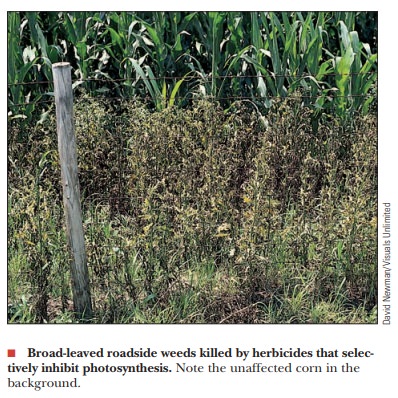Chapter: Biochemistry: Photosynthesis
Killing Weeds by Inhibiting Photosynthesis
Killing Weeds
by Inhibiting Photosynthesis
The main purpose of herbicides is to kill weeds so that they do not
choke out desirable plants. One way of doing this is by selectively inhibiting
photosynthesis in the weeds and not in the desired plants. A prime example is
the use of 2,4-D and 2,4,5-T to kill broad-leaved weeds such as dandelions
without affecting the growth of grasses. In terms of acreage, lawn grasses are
the most widely grown crop in the United States.
The selectivity of herbicides is not absolute and depends on a
number of factors. Transport of the herbicide to the site of action in the
plant plays a role, as does absorption. One of the most important features is a
higher rate of detoxification of the herbicide in the desirable plants when
compared with the weeds.

A number of other herbicides interfere with photosynthesis in
specific ways. Amitrole inhibits biosynthesis of chlorophyll and carotenoids.
The affected plants present a bleached appear-ance before they die because of
the loss of their characteristic pigments. Another herbicide, atrazine,
inhibits the oxidation of water to hydrogen ion and oxygen. Still other
herbicides interfere with electron transfer in the two photosystems. In
photosystem II, diuron inhibits electron transfer to plastoquinone, whereas
bigyridylium herbicides accept electrons by competing with the electron
acceptors in photosystem I. The inhibitors active in photosystem I include
diquat and paraquat. The latter substance attained some notoriety when it was
used to interfere with anillegal crop: it was sprayed on marijuana fields to
destroy the growing plants.
Related Topics